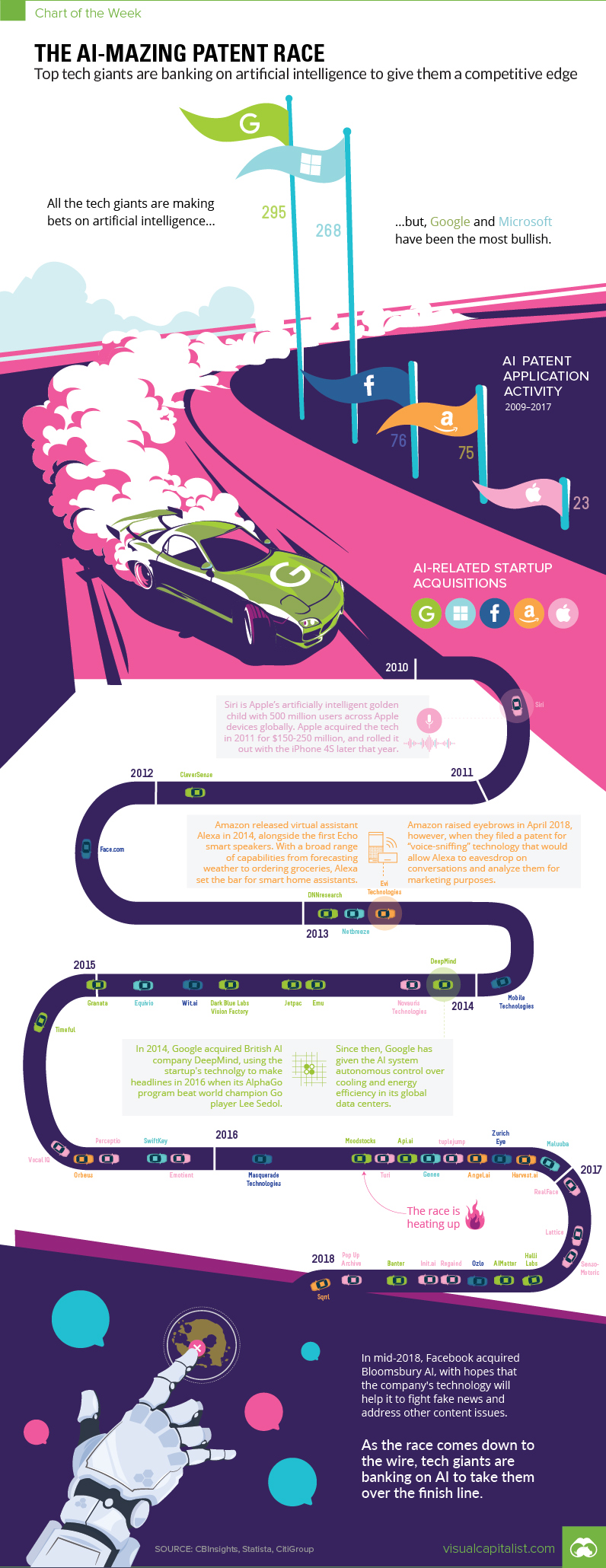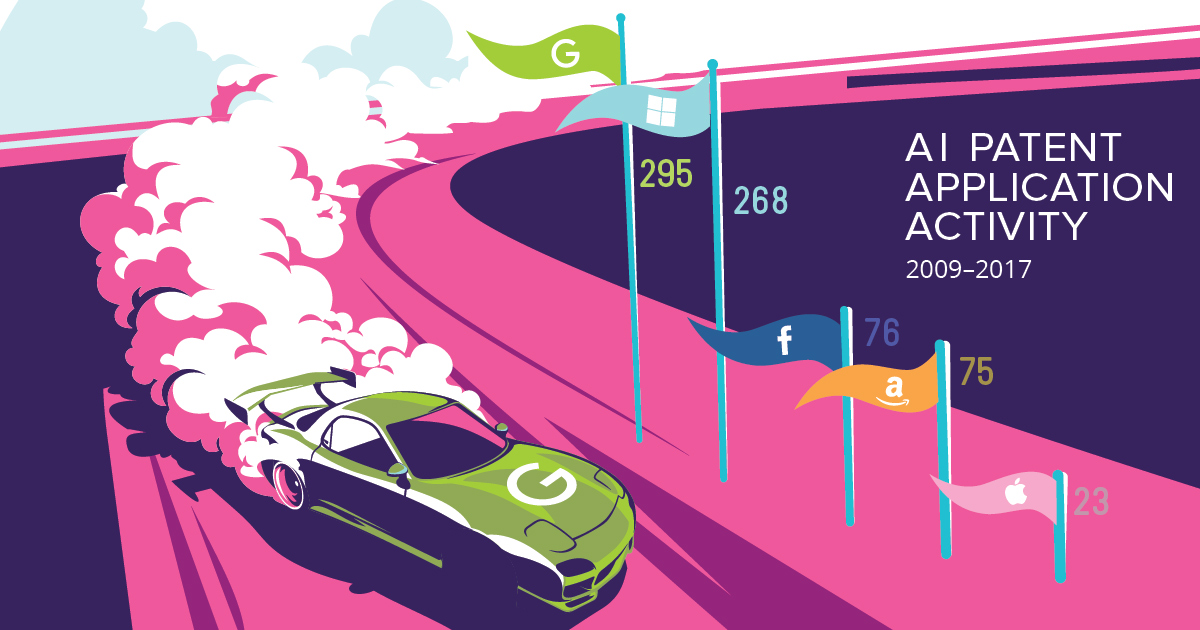Technology
Chart: The AI-mazing Patent Race

Chart: The AI-mazing Patent Race
The Chart of the Week is a weekly Visual Capitalist feature on Fridays.
Artificial Intelligence is transforming the way we live, and the tech giants are racing to stay ahead of the curve.
AI-related funding totaled an estimated $15.2 billion in 2017, a 144% increase over the previous year. The U.S. tech industry leads with a 50% share of those investments, even with China swiftly closing the gap in terms of patents and AI research.
AI itself isn’t new, but boosted computing power, increased connectivity, and the sheer volume of data has paved the way for the fourth industrial revolution of AI.
“The coming era will be looked back upon as the ‘AI era,’ when AI became the defining competitive advantage for corporations, government agencies, and investment professionals,” predicts David Nadler, founder of Kensho Technologies.
The Potential of AI
Artificial Intelligence is less about sentience and more about accelerated learning.
AI technology looks for patterns, learns from experience, and predicts responses based on historical data. An AI-powered computer can’t produce a unique thought, but it can probably predict yours. The end result: AI is able to learn new things at such a speed that it can predict your behavior and preempt your requests.
From the advancements in natural language processing that make Siri and Alexa possible, to the machine learning advancements that give robo-advisors their trading chops, AI’s ability to simulate human thinking means it can also streamline our lives. It can preempt our needs and requests, making products and services more user friendly as machines learn our needs and figure out how to serve us better.
This makes AI a vital source of competitive advantage.
AI’s Competitive Advantage
In their quest to stay on top of the Silicon Valley food chain, familiar tech and retail giants are dipping their toes in AI to execute diverse strategies:
Amazon
Amazon leverages AI technology to analyze and predict your shopping patterns. Alexa is very Artificially Intelligent indeed, and the revolutionary Amazon Go model continues to push the boundaries of AI tech on the ground.
Google
Google uses machine learning and pattern recognition in its search and facial recognition services, as well as natural language processing for real-time language translation. The company has also released a series of smart home products, like the Nest thermostat. After acquiring more than 50 AI startups in 2015-16, this seems like only the beginning for Google’s AI upgrade.
Microsoft
Microsoft’s Cortana is powered by machine learning, allowing the virtual assistant to build insight and expertise over time. In 2016, the tech giant added Research and AI as their fourth silo alongside Office, Windows, and Cloud, with the stated goal of making broad-spectrum AI application more accessible and everyday machines more intelligent.
Apple
Apple is notoriously tight-lipped about their AI research, but it’s safe to say Siri is only the tip of the iceberg. The tech giant received a patent this year for augmented-reality glasses, slated for a release in 2020.
Facebook
Facebook uses artificial intelligence to suggest photo tags, populate your newsfeed, and detect bots and fake users. The social media giant has also come under fire for their widespread use of AI analytics to target users for marketing and messaging purposes.
These tech kings are driving the research that will increasingly intertwine our lives with artificial intelligence, and it’s that investment that just might secure their future.
Technology
Visualizing AI Patents by Country
See which countries have been granted the most AI patents each year, from 2012 to 2022.

Visualizing AI Patents by Country
This was originally posted on our Voronoi app. Download the app for free on iOS or Android and discover incredible data-driven charts from a variety of trusted sources.
This infographic shows the number of AI-related patents granted each year from 2010 to 2022 (latest data available). These figures come from the Center for Security and Emerging Technology (CSET), accessed via Stanford University’s 2024 AI Index Report.
From this data, we can see that China first overtook the U.S. in 2013. Since then, the country has seen enormous growth in the number of AI patents granted each year.
| Year | China | EU and UK | U.S. | RoW | Global Total |
|---|---|---|---|---|---|
| 2010 | 307 | 137 | 984 | 571 | 1,999 |
| 2011 | 516 | 129 | 980 | 581 | 2,206 |
| 2012 | 926 | 112 | 950 | 660 | 2,648 |
| 2013 | 1,035 | 91 | 970 | 627 | 2,723 |
| 2014 | 1,278 | 97 | 1,078 | 667 | 3,120 |
| 2015 | 1,721 | 110 | 1,135 | 539 | 3,505 |
| 2016 | 1,621 | 128 | 1,298 | 714 | 3,761 |
| 2017 | 2,428 | 144 | 1,489 | 1,075 | 5,136 |
| 2018 | 4,741 | 155 | 1,674 | 1,574 | 8,144 |
| 2019 | 9,530 | 322 | 3,211 | 2,720 | 15,783 |
| 2020 | 13,071 | 406 | 5,441 | 4,455 | 23,373 |
| 2021 | 21,907 | 623 | 8,219 | 7,519 | 38,268 |
| 2022 | 35,315 | 1,173 | 12,077 | 13,699 | 62,264 |
In 2022, China was granted more patents than every other country combined.
While this suggests that the country is very active in researching the field of artificial intelligence, it doesn’t necessarily mean that China is the farthest in terms of capability.
Key Facts About AI Patents
According to CSET, AI patents relate to mathematical relationships and algorithms, which are considered abstract ideas under patent law. They can also have different meaning, depending on where they are filed.
In the U.S., AI patenting is concentrated amongst large companies including IBM, Microsoft, and Google. On the other hand, AI patenting in China is more distributed across government organizations, universities, and tech firms (e.g. Tencent).
In terms of focus area, China’s patents are typically related to computer vision, a field of AI that enables computers and systems to interpret visual data and inputs. Meanwhile America’s efforts are more evenly distributed across research fields.
Learn More About AI From Visual Capitalist
If you want to see more data visualizations on artificial intelligence, check out this graphic that shows which job departments will be impacted by AI the most.
-

 Mining1 week ago
Mining1 week agoGold vs. S&P 500: Which Has Grown More Over Five Years?
-

 Markets2 weeks ago
Markets2 weeks agoRanked: The Most Valuable Housing Markets in America
-

 Money2 weeks ago
Money2 weeks agoWhich States Have the Highest Minimum Wage in America?
-

 AI2 weeks ago
AI2 weeks agoRanked: Semiconductor Companies by Industry Revenue Share
-

 Markets2 weeks ago
Markets2 weeks agoRanked: The World’s Top Flight Routes, by Revenue
-

 Countries2 weeks ago
Countries2 weeks agoPopulation Projections: The World’s 6 Largest Countries in 2075
-

 Markets2 weeks ago
Markets2 weeks agoThe Top 10 States by Real GDP Growth in 2023
-

 Demographics2 weeks ago
Demographics2 weeks agoThe Smallest Gender Wage Gaps in OECD Countries














